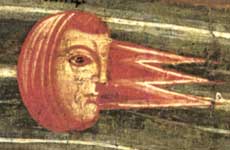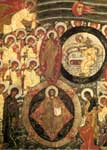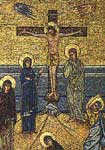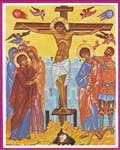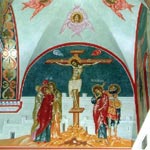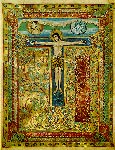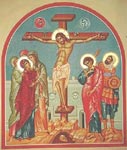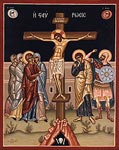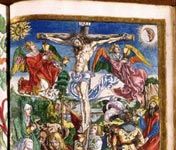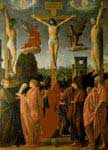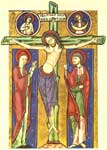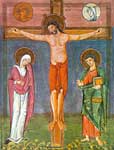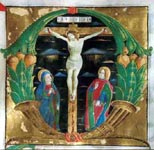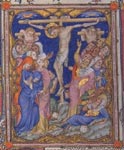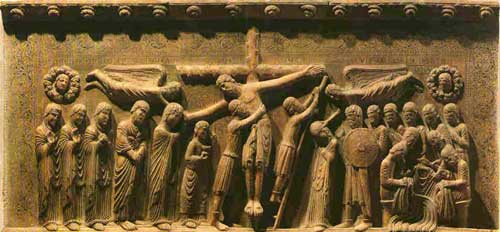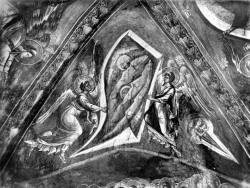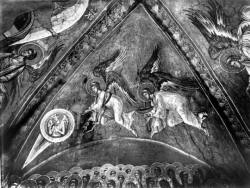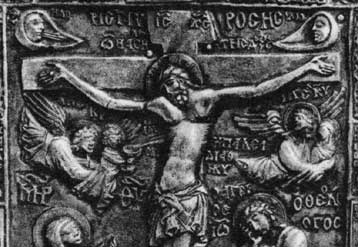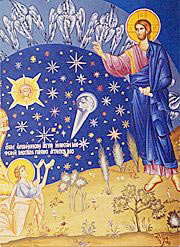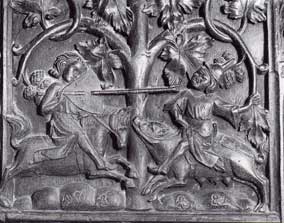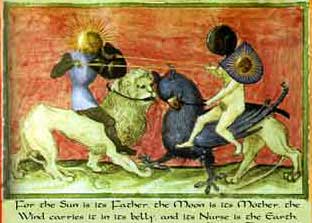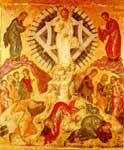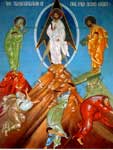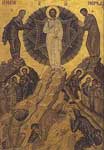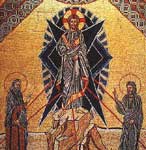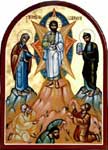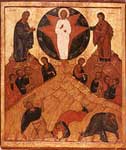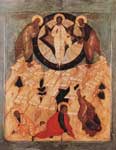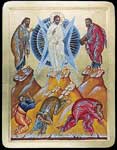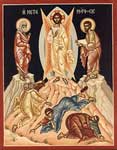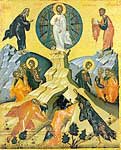CRUCIFIXION
Svetitskhoveli Cathedral, Mtskheta, Georgia
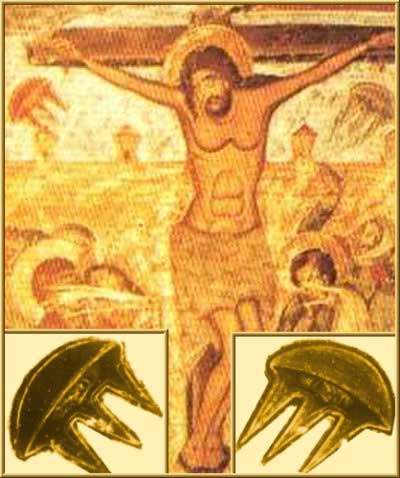
This is one of the most widely known cases of the misunderstanding of an artwork. It has been published on many UFO web pages. But those who are familiar with symbolism in medieval art understand that there are no mysterious elements in this holy painting. In fact in the most of the crucifixions done in the Byzantine style show the same “objects” on either side of the cross. They are the Sun and the Moon, often represented with a human face or figure.

Here is a description of the scene surrounding the crucifixion in one Byzantine painting:
" At the top are four angels. One half-length pair, flanking the arms of the cross, is in mourning. The other pair, above, is in flight. The angel at the top left introduces a bright female personification while gesturing toward the sun. The opposite angel expels a dark personification to the other side of the moon. This juxtaposition of light and dark, positive and negative, is central to the interpretation of the panel as representing man’s redemption through Christ’s death.”
(http://www.st-mary-mons.org/english/ancient_icon_of_crucifixion_13th.htm)
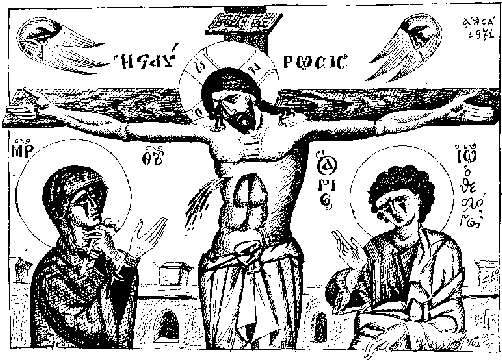
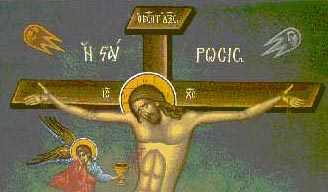
Here is a small sample of crucifixions in the Byzantine style, showing the Sun and the Moon with human attributes:
But not only in Byzantine Orthodox icons do we find the Sun and the Moon in Crucifixions. They are also found in the work of painters like Dürer, Crivelli, Raffaello, and Bramantino:
Other crucifixions found in illuminated medieval manuscripts:
Conclusions:
The Mtskheta Crucifixion contains no UFOs. The two objects near the cross are an anthropomorphic representation of the Sun and the Moon shown in much the same way as in many other Byzantine Crucifixions.
CRUCIFIXION
Visoki
Decani Monastery, Kosovo
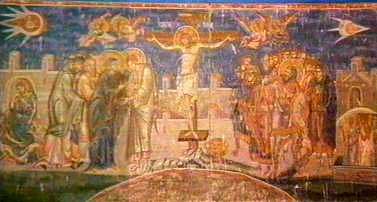
This 16th century Crucifixion, a fresco in the Visoki Decani Monastery in Kosovo, is, like the previous one, considered a UFO-painting. The two strange objects at the sides of the cross are considered to be the UFOs:
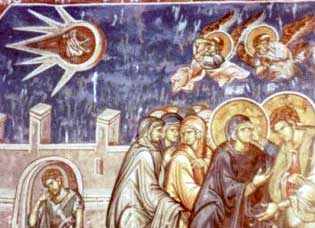
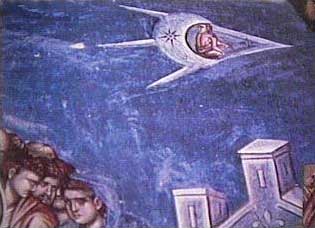
(images from: Zonamagica,
BibelskeBeretninger and
Bible
Ufo Connection )
This is one of the oldest documented UFO-in-art cases because the first articles about it were published in the sixties, in the French magazine “Spoutnik.” This fresco was “discovered” by Alexandar Paunovitch, a student at the Academy of Arts of Yugoslavie in 1964. After this early publicity, the pictures were featured in many books about UFOs. On many web pages we read that the two objects in the sky are, without any doubt, “spaceships with crew.”
But this Crucifixion also follows the common iconographic model of the Middle Ages. The “Deposition from the Cross” of Benedetto Antelami, in the Dome of Parma in particular resembles the Crucifixion of Visoki Decani.
On the edges of the composition, in the same position as in the fresco of Visoki Decani, the Sun and the Moon are represented as human witnesses to the Crucifixion just as they are in the previous painting. In both art works the figures who represent the Sun and the Moon look towards the Cross that is located in the center of the composition.
The Sun and Moon, represented as human figures, are visible in many Byzantine-Orthodox sacred paintings, therefore as we have seen in the previous understood one it, dedicated to the Crucifixion of Mtskheta.
Below a particular of an ancient Gospel (Treasure of Saint Clement, sec. XIV) and a modern byzantine fresco:
James Hall, author of the "Dictionary of Subjects & Symbols In Art" writes:
“ The sun and moon, one on each side of the cross, are a regular feature of Medieval crucifixions. They survived into the early Renaissance but are seldom seen after the 15th century. Their origin is very ancient. It was the custom to represent the sun and moon in images of the pagan sun gods of Persia and Greece, a practice that was carried over into Roman times on coins depicting the emperors.”
(...) The sun is sometimes represented as simply a man’s bust with a radiant halo, the moon as a woman’s with the crescent of Diana. Later they are reduced to two plain disks, the moon having a crescent within the circle, may be borne by angels. The sun appears on Christ's right, the moon on his left.”
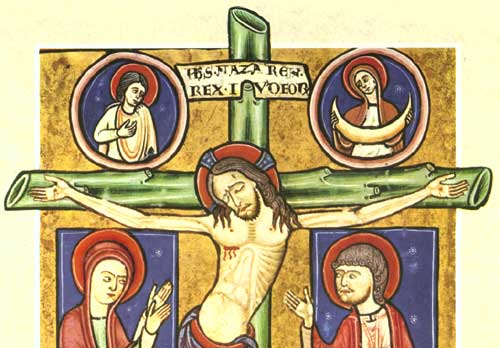
Spesso il Sole e la Luna venivano rappresentati come personaggi dalle fattezze umane alla guida di carri trainati rispettivamente da cavalli e da buoi, come in questo bassorilievo in avorio che fa parte della rilegatura del "Libro delle Pericopi di Enrico II" del XI secolo (Monaco, Bayerische Staatsbibliothek):
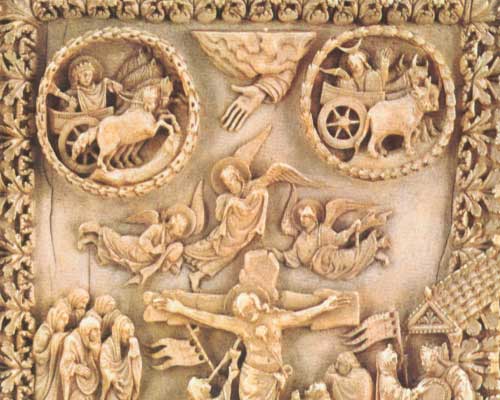
e in questa lunetta del Duomo di Parma, che raffigura un episodio della storia di Barlaam e Josafat, scolpita da Benedetto Antelami:
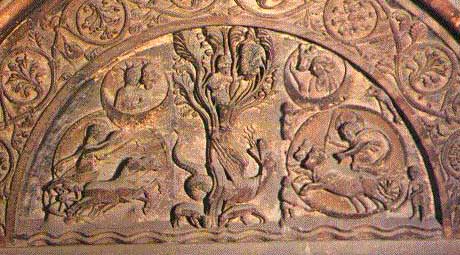
In questo caso le figure del Sole e della Luna vengono raddoppiate in quelle del Giorno e della Notte, che sembrano in combattimento tra loro.
Nel caso della Crocifissione di Visoki Decani si potrebbe però azzardare una ipotesi più complessa che potrà essere confermata o smentita solo da un esame più dettagliato dell'affresco e della sua storia, cosa che al momento, sulla base delle sole piccole illustrazioni reperibili nel web, non è possibile.
Ai lati della Croce nel bassorilievo di Antelami vediamo le due figure chiamate Ecclesia e Sinagoga. La prima raccoglie in una coppa il sangue di Cristo mentre la seconda è costretta da un angelo a chinare il capo in segno di sottomissione.
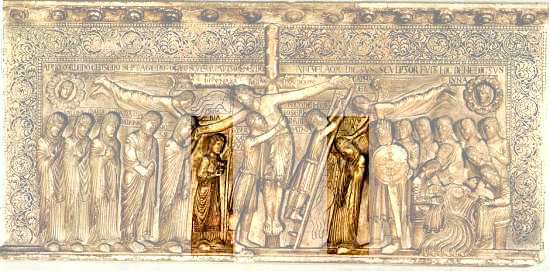
«Non sono mancati nell'iconografia, come nella letteratura cristiana antica e medievale, gli accenti polemici che contrapponevano la Chiesa alla Sinagoga. Basti ricordare la famosa Deposizione dalla croce di Benedetto Antelami (1178) nella cattedrale di Parma. Sotto le enormi braccia di Cristo, la Ecclesia accoglie in un grande calice il sangue che sgorga come un fiume dal fianco squarciato di Cristo, mentre, sul lato opposto, la Sinagoga è colpita da un angelo e perde la corona dal suo capo.»
(http://www.webitaly.com/hellenismos/tamburr.htm)«Nel mosaico (V secolo) posto all’interno della chiesa di Santa Sabina in Roma, sopra il portale principale, due figure muliebri rappresentano rispettivamente l’Ecclesia ex gentibus e l’Ecclesia ex circumcisione, ovvero le due correnti del cristianesimo primitivo. Nel Medioevo invece la figura dell’Ecclesia appare contrapposta a quella simboleggiante la Sinagoga, cioè la religione ebraica (duomo di Bamberg).» (http://www.esonet.org/dizionario/e00.htm)
L'Ecclesia e la Sinagoga scolpite sulla facciata del duomo di Strasburgo e in quello di Bamberg:
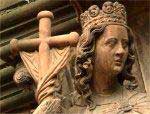
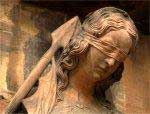
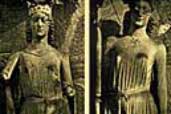
In un bassorilievo del coro della Cattedrale di Erfurt in Turingia vediamo rappresentata l'Ecclesia che con una lancia colpisce la Sinagoga, in una composizione molto simile a quella della lunetta con la storia di Barlaam e Josafat, anche per la presenza dell'albero della vita. Ma la stessa scena compare anche in molte raffigurazioni alchemiche del combattimento tra il Sole e la Luna (lo zolfo e il mercurio).
In queste vetrate vediamo l 'Ecclesia che trionfa sulla Sinagoga, le prime si trovano nel duomo di Werben, le seconde nel duomo di Munster:
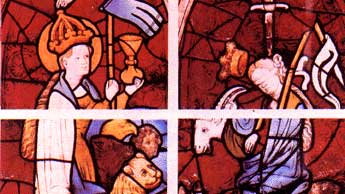
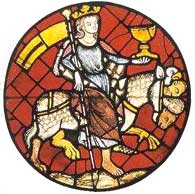
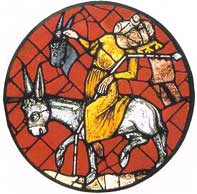
L'Ecclesia tiene in mano la coppa, con lo stesso gesto del personaggio all'interno del Sole nell'affresco di Decani. La Sinagoga, bendata e col vessillo spezzato, china il capo e perde la corona.
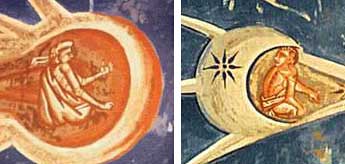
Si potrebbe perciò ipotizzare che nell'affresco di Decani sia stata raffigurata l'Ecclesia (Il Sole) che trionfa sulla Sinagoga (la Luna). Il personaggio all'interno del Sole pare reggere qualcosa con una mano, potrebbe anche in questo caso essere la coppa col sangue di Cristo. Sarebbe interessante verificare anche se nell'affresco di Decani il personaggio all'interno della Luna è bendato. Le piccole immagini reperibili nel web non permettono di vedere bene il viso, che però presenta una evidente parte più scura all'altezza degli occhi. E' infatti con una benda sugli occhi che veniva spesso rappresentata la Sinagoga, a simboleggiare il rifiuto degli Ebrei di vedere in Gesù il Messia promesso.
Conclusions:
In the Visoki Decani Crucifixion fresco there are no UFOs. The two objects near the cross are anthropomorphic symbols of the Sun and the Moon, represented in much the same way as they are in many other Byzantine Crucifixions.
Arte bizantina, Trasfigurazione di Cristo
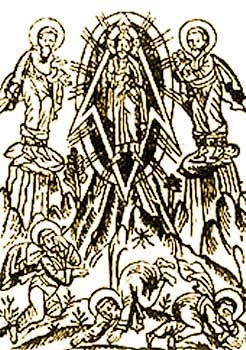
Anche questa immagine viene interpretata in senso ufologico in molti siti web. Questo è il commento che si legge nelle pagine di Edicolaweb:
«Affresco del Quattrocento visibile a Kiev, ove è chiara la rappresentazione di Gesù dentro un razzo in movimento di ascesa, sorretto da due angeli in piedi su due nuvole che si muovono in sintonia verso l’alto, con tanto di scia a evidenziarne il movimento ascensionale.»
Sarebbe bastato aprire i Vangeli e leggere la descrizione di questa scena per capire il soggetto del disegno. Ecco la Trasfigurazione descritta nel vangelo secondo Marco:
«Dopo sei giorni, Gesù prese con sé Pietro, Giacomo e Giovanni e li portò sopra un monte alto, in un luogo appartato, loro soli. Si trasfigurò davanti a loro e le sue vesti divennero splendenti, bianchissime: nessun lavandaio sulla terra potrebbe renderle così bianche. E apparve loro Elia con Mosè e discorrevano con Gesù. Prendendo allora la parola, Pietro disse a Gesù:
«Maestro, è bello per noi stare qui; facciamo tre tende, una per te, una per Mosè e una per Elia!».
Non sapeva infatti che cosa dire, poiché erano stati presi dallo spavento. Poi si formò una nube che li avvolse nell'ombra e uscì una voce dalla nube: «Questi è il Figlio mio prediletto; ascoltatelo!». E subito guardandosi attorno, non videro più nessuno, se non Gesù solo con loro. »
E anche in questo caso si tratta di una raffigurazione in stile bizantino, ripetuta da secoli in modi pressoché identici:
Questa ultima immagine viene dalle pagine web di una chiesa ortodossa americana:
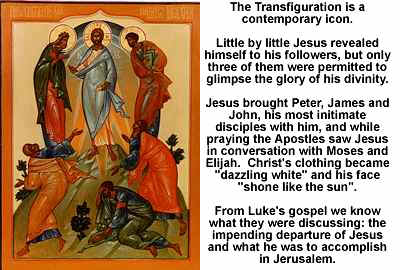
Conclusions:
In the image called "Kiev fresco" there are no UFOs or rockets. It is simply a representation of the "Transfiguration" of Jesus in bizantine style, similar to every other Orthodox Tranfiguration icons.
